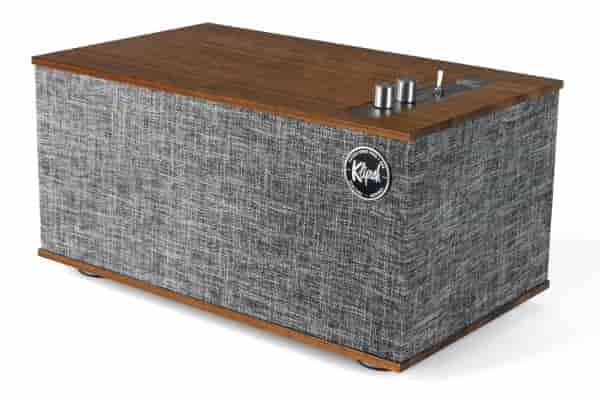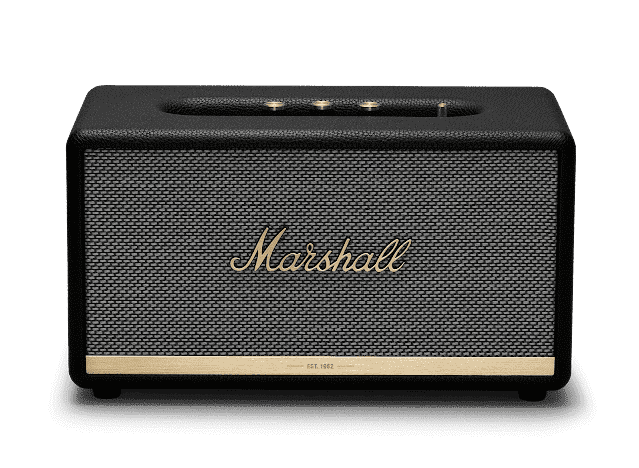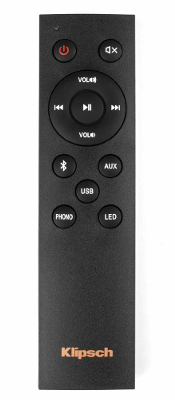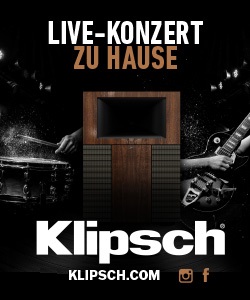The Klipsch The Three II is the largest active speaker in the Heritage Wireless series to date. Even a cursory glance at the Three II will be enough to understand that Klipsch took a slightly different approach to its design than, for example, Harman Kardon in their Citation 500.
Klipsch The Three ii vs Marshall Stanmore ii
A deeper examination of this column will show that the difference between the two models is not only in design. In general, active acoustics as a class of Hi-Fi technology is still in development, and there are no uniform criteria for its creation. With The Three II, for example, Klipsch ditched the Chromecast and other smart streaming features in favor of Bluetooth and easier connectivity – and as we'll see, the result is just as impressive as the speaker's appearance.
Klipsch The Three II Audio System Review
This means that Three II may either be exactly what you are looking for or not at all. However, let's take a closer look at Klipsch's The Three II to see where its worth lies. Of course, at a modest cost in terms of output power and speaker equipment, The Three II is not inferior to much more expensive competitors, and its chic retro design plays in favor of Klipsch. Well, we will now evaluate the possibilities of this column.
 |
| image credit: Klipsch |
Specification and Design
Klipsch The Three II is an active speaker in one package. The latter is made closed and it has two 2.25-inch full-range speakers, complemented by a 5.25-inch subwoofer and a pair of 5.25-inch passive woofers. This combination appears to work very well, as Klipsch has labeled The Three II with a frequency response of 45Hz (3dB, the most stringent acoustic measurement). In other words, this speaker will not lack bass. The rated power for this model is 60 W, and this is at acceptable levels of distortion.
The only thing missing from the Three II, which makes it an unusual model for Klipsch, is the lack of horn drivers. There is nothing surprising here, since horn drivers would take up too much of the body of such a compact speaker. The Three II does not have separate tweeters at all, as it is equipped with full-range speakers. This greatly simplified the design of the column.
The Klipsch The Three II sets itself apart from many competitors in its connectivity options as well. The company has exactly the same column, with the name The Three Google Assistant and support for the voice control system of the same name. However, the Three II has no networking features at all: UPnP, AirPlay, or Chromecast. But this column has something that I complained about the lack of during reviews of other similar models. We'll talk about this a little later, but for now we note the presence of Bluetooth version 4.0 with support for the improved aptX codec, but not AAC (as far as I can tell).
The column also has a pair of analog inputs. One of them is implemented on a 3.5 mm mini-jack connector, and the second on RCA. And this second one opens the list of unusual features of The Three II. The RCA input can accept either a regular line signal or an MM signal when switched to Phono mode. Admittedly, most of the turntables that may be connected to the Klipsch The Three II already have a built-in phono stage, and therefore such a function cannot be considered unequivocally in demand. But, in any case, this is what distinguishes the Klipsch column from almost all other competitors.
The Klipsch The Three II also has a 24-bit/192 kHz USB input, which is also quite unusual for this class of acoustics. Nevertheless, there is a certain sense in the presence of such a connection. If The Three II is used as a desktop audio system next to a PC, then it will have a clear advantage over almost all competitors. Unfortunately, unlike, for example, the R41 PM, there is no optical input that can be used to connect to a TV. However, for a model of this class, this is not very critical. More disappointing is the lack of a USB port to charge your phone or tablet (or even to power some possible signal sources). The device has only USB for service purposes, but it is not suitable for powering anything.
 |
| image credit: Klipsch |
Now let's move on to the design of The Three II. I will immediately note that in its appearance this column is not for everyone. If you live in an ultra-modern interior that "plays light with subtle lines of objects," then Three II will look like a plate of juicy beef chop at a vegan food festival.
Thing is, Klipsch didn't just use some common tricks to create a "retro design" in this column. If, by some miracle, The Three II was moved to the sixties of the last century, then it would be recognized as a real Klipsch column of that time. And this is connected not only with the finish, but also, for example, with convenient and understandable controls that are pleasant to the touch. At the same time, you get a completely non-retro, but easy-to-use remote control that makes up for the lack of a control app.
Just as importantly, Klipsch feels confident as an "old school" brand. The natural wood veneer finish is not overly chic, it is exactly what it should be for a mid-century column, and looks very reliable. The simple and logical control of The Three II makes it independent of the operation of any software, which may not always be stable.
How was Klipsch The Three II tested?
The Thtree II was connected to an IsoTek Evo3 Corvus surge protector/air conditioner and worked with Essential PH-1 and Sony Xperia XA2 smartphones to test Bluetooth. The USB input was tested with SOtM SMS-200 Neo and the line-in with Google Chromecast Audio. The MM input was tested using a Michell Gyrodec turntable with a Goldring 2500 cartridge. Materials used include FLAC, AIFF and ALAC, TIDAL and Deezer, as well as a number of LPs.
Sound quality
It must be said right away that the Klipsch sound does not have a retro character. If you are hoping that its sound will be overflowing with mids to the detriment of highs and lows, then this is not the case. In fact, we have to admit that Klipsch sounds amazing. With a Sony smartphone, the Klipsch speaker worked very stably and sounded great. For a closed cabinet with reasonably sized speakers, The Three II delivered excellent bass. They had such depth that even the most complex music sounded quite convincing. At the same time, by the nature of the sound, it was impossible to assume that the column has a separate woofer and two more passive radiators. Listen to The Three II and you will think that only two full-range speakers work, so the speaker has a consistent sound. Yes, the overall picture is not very “stereo”, but it is the same for competing models.
If you have a Chromecast Audio box, Klipsch will do even better. Take a little time to connect it and you will understand how The Three II managed to turn its weak side into a strong one. The fact that you can connect any streaming or Voice Assistant device to it, rather than being limited to built-in, makes the speaker very flexible to use. It would be even better if The Three II had a USB connector to power such sources. The USB input also works well. I don't know how many people will use it, but its ability to receive High Resolution audio is inspiring anyway. If you are looking for a quality speaker for listening to music from your computer, then Klipsch is a great choice. And one can only regret once again that The Three II does not have an optical input.
The built-in phono stage is also quite good. Sounding close to that of the R41 PM, it has minimal background noise and a transparent sound that allows you to hear the player's individual character. The possibility of such a connection will certainly come in handy for those who have a turntable without a built-in phono stage.
 |
| image credit: Klipsch |
Pros
Wide and rich sound
Good flexibility of use
Nice retro design
Cons
No streaming features
No USB power output
Appearance for an amateur
Conclusion
The Klipsch The Three II is an unusual speaker, and you'll realize it once you've spent enough time with it. Its feature set looks odd compared to many of its competitors, but it provides flexibility in choosing an external streaming device, including one with a "voice assistant" function. This speaker combines a deceptively simple set of inputs with a sound that rivals the Bluesound Pulse 2i, which costs almost 1.5 times more. The design of the Klipsch The Three II may not be for everyone, but thanks to the high quality workmanship and finish, this speaker will still appeal to many. And with all that said, we conclude that The Three II is worthy of our warmest recommendation.
Verdict
8 out of 10
Key Features of Klipsch The Three II
Configuration: 2.1
Speakers: 2 x 57mm full range drivers + 133mm woofer
Passive Radiators: 2 x 133mm
Frequency range: 45 Hz - 20 kHz (-3 dB)
Output power: 120W (maximum)
Sound pressure: 106 dB
Inputs: line (mini-jack 3.5 mm), line/Phono (RCA), USB, Bluetooth
USB signal: up to 24 bit / 192 kHz
Dimensions (W x H D): 348 x 179 x 203 mm
Weight: 4.7 kg
Marshall Stanmore II Voice review
The Marshall Stanmore II Voice smart speaker has better sound than the Bluetooth Stanmore II, as well as the capabilities of Amazon Alexa or Google Assistant voice assistants.
Few can compete with the $399.99 Stanmore II Voice in the wireless smart speaker category. With the power of an Amazon Alexa or Google Assistant voice assistant, the Marshall Stanmore II Voice has improved sound quality with undistorted, deep bass. This makes it more attractive than other Marshall wireless speakers and one of the best high-end smart speakers you can buy today.
Design
 |
| image credit: Marshall |
The Stanmore II Voice measures 195mm high, 350mm wide and 185mm deep, and weighs over 4.7kg. The front cloth grille and black leather-like body are visually the image of the previous Stanmore II Bluetooth model, however wherever the Bluetooth version includes a power switch, the Voice model has a electro-acoustic transducer button.. This button mute or unmute the dual microphone system, which uses noise cancellation to hear voices clearly several meters away. The four small status lights, located on the lower right side of the front panel, glow and pulse white when the microphone is on and solid amber when it is off.
Otherwise, the top panel is almost the same as the previous Stanmore II Bluetooth model. The 3.5mm input (optional cable not included) and audio source button are on the left, where you can choose between Aux, Bluetooth, RCA, and Wi-Fi inputs. In the middle of the panel are three knobs, one for each volume level, bass and treble. Levels are displayed by red illuminated LEDs that surround each knob. To the right of this is a play/pause button, but no track controls.
On the back, the speaker has a stereo RCA input (again, cables not included) and an input for connecting the supplied power cable. The top, front, and side panels look fantastic if the retro design suits your tastes, but the back panel isn't as good. It's finished in black with the brand logo and warning information, which is a really bad design decision that will make you want to place the speaker close to the wall so you don't have to look at the back.
The Stanmore II Voice uses one 50-watt Class D subwoofer amplifier and two 15-watt tweeter amplifiers to provide a frequency range of 50 Hz to 20 kHz.
Setup and functionality
We tested the speaker version with Google Assistant. In this case, the Googe Home app is your ticket to get the most out of it. You also need to download it for the initial setup of the column. Once set up and connected to a Wi-Fi network, however, you can more or less dispense with the app if you wish. In general, the setup is very simple.
Most of the things you can do in the app, in terms of playing music, can be done with voice commands. Far-field microphones pick up voices exceptionally well. You can be at a distance of 6 meters or more and mumble something, while listening to music, the speaker will hear you and execute the command.
The Google Assistant in the Stanmore II Voice supports Google Cast, which allows you to connect your speaker just like a Chromecast Audio. The Google Cast platform, controlled through the Google Home app, supports multi-room audio with the ability to stream music over Wi-Fi simultaneously to multiple speakers located in different locations in your home. The Amazon Alexa version of the Stanmore II Voice will eventually support similar multi-room streaming, but is not currently available.
 |
| image credit: Marshall |
Sound
Bass and treble controls allow you to fine-tune the sound. With the levels set to halfway, the Stanmore II tone delivers a powerful low end on tracks with intense sub-bass sounds, such as The Knife's "The Silent Shout". One notable difference between this speaker and the Bluetooth Stanmore II is that there is no distortion in this composition at maximum volume. This may seem impossible using the same speakers and amplifiers, but this speaker has a slightly higher maximum SPL of 107dB (as opposed to 101dB).
Bill Callahan's Drover, a track with much less bass in the mix, gives us a better feel for the Stanmore II Voice's overall soundscape. The drums get a powerful presence that doesn't sound too overpowered at low frequencies. Callahan's baritone vocals sound rich. Acoustic guitar strings and drums sound bright with a treble effect.
Good
Yes, the price is high, but the presence of Amazon Alexa or Google Assistant certainly adds value to the speaker and is enough to give a higher rating than its predecessor.
pros
- Powerful sound with rich bass depth and crisp highs.
- Beautiful design.
- Microphones easily pick up voice from great distances.
- Amazon Alexa and Google Assistant models are available.
Minuses
- Ugly back panel.
- Audio cables are not included.














.jpg)



0 Comments